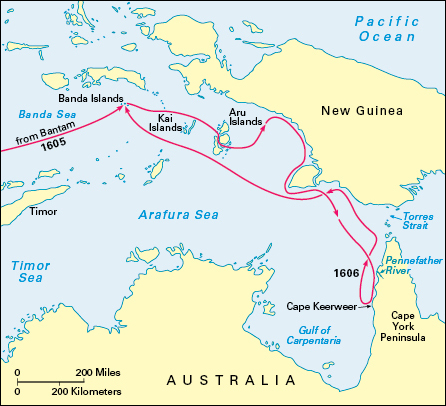Jansz, Willem (1570?-?), also known as Willem Janszoon, was a Dutch navigator who is thought to be the first European to see and land on the Australian continent. Jansz and another Dutchman, Jan Lodewycksz, came upon the continent while on the first voyage sponsored by the Dutch East India Company to explore trade routes south of the Indies (now Indonesia ). In the early 1600’s, the Dutch East India Company controlled the lucrative East Indies spice trade .

Jansz’s expedition sailed from the port of Bantam (near present-day Jakarta, Indonesia) on Nov. 18, 1605, in a small, three-masted ship called the Duyfken (Little Dove). The ship’s small size and maneuverability made it ideal for voyages through uncharted waters.
After leaving Bantam, Jansz sailed to the Kai and Aru islands and then set his course for the unknown coasts of New Guinea. He sailed east along the south coast of New Guinea, going ashore several times to investigate the land and its inhabitants. On one such expedition, eight members of his crew were killed.
From New Guinea, Jansz and Lodewycksz sailed into the Cape of Carpentaria and first touched Australian soil at the mouth of the Pennefather River on the Cape of York, probably in March 1606. They charted the Australian coast south from Pennefather River for about 200 miles (320 kilometers). When they reached a point that Jansz called Cabo Keerweer (now Cape Keerweer), shortages of food and water and reduced crew numbers forced Jansz to cut short the voyage. The Duyfken then returned to Banda, the nearest Dutch port.
Jansz was born in Amsterdam, the Netherlands . He became an admiral and also served as the governor of Banda. He was still working for the East India Company when he returned to the Netherlands in 1628. Nothing is known about him after this date.
